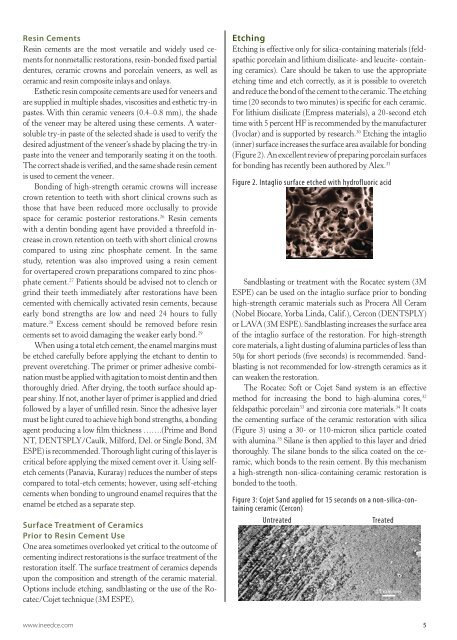A Practical Guide to the Use of Luting Cements - IneedCE.com
A Practical Guide to the Use of Luting Cements - IneedCE.com
A Practical Guide to the Use of Luting Cements - IneedCE.com
Create successful ePaper yourself
Turn your PDF publications into a flip-book with our unique Google optimized e-Paper software.
Resin <strong>Cements</strong><br />
Resin cements are <strong>the</strong> most versatile and widely used cements<br />
for nonmetallic res<strong>to</strong>rations, resin-bonded fixed partial<br />
dentures, ceramic crowns and porcelain veneers, as well as<br />
ceramic and resin <strong>com</strong>posite inlays and onlays.<br />
Es<strong>the</strong>tic resin <strong>com</strong>posite cements are used for veneers and<br />
are supplied in multiple shades, viscosities and es<strong>the</strong>tic try-in<br />
pastes. With thin ceramic veneers (0.4–0.8 mm), <strong>the</strong> shade<br />
<strong>of</strong> <strong>the</strong> veneer may be altered using <strong>the</strong>se cements. A watersoluble<br />
try-in paste <strong>of</strong> <strong>the</strong> selected shade is used <strong>to</strong> verify <strong>the</strong><br />
desired adjustment <strong>of</strong> <strong>the</strong> veneer’s shade by placing <strong>the</strong> try-in<br />
paste in<strong>to</strong> <strong>the</strong> veneer and temporarily seating it on <strong>the</strong> <strong>to</strong>oth.<br />
The correct shade is verified, and <strong>the</strong> same shade resin cement<br />
is used <strong>to</strong> cement <strong>the</strong> veneer.<br />
Bonding <strong>of</strong> high-strength ceramic crowns will increase<br />
crown retention <strong>to</strong> teeth with short clinical crowns such as<br />
those that have been reduced more occlusally <strong>to</strong> provide<br />
space for ceramic posterior res<strong>to</strong>rations. 26 Resin cements<br />
with a dentin bonding agent have provided a threefold increase<br />
in crown retention on teeth with short clinical crowns<br />
<strong>com</strong>pared <strong>to</strong> using zinc phosphate cement. In <strong>the</strong> same<br />
study, retention was also improved using a resin cement<br />
for overtapered crown preparations <strong>com</strong>pared <strong>to</strong> zinc phosphate<br />
cement. 27 Patients should be advised not <strong>to</strong> clench or<br />
grind <strong>the</strong>ir teeth immediately after res<strong>to</strong>rations have been<br />
cemented with chemically activated resin cements, because<br />
early bond strengths are low and need 24 hours <strong>to</strong> fully<br />
mature. 28 Excess cement should be removed before resin<br />
cements set <strong>to</strong> avoid damaging <strong>the</strong> weaker early bond. 29<br />
When using a <strong>to</strong>tal etch cement, <strong>the</strong> enamel margins must<br />
be etched carefully before applying <strong>the</strong> etchant <strong>to</strong> dentin <strong>to</strong><br />
prevent overetching. The primer or primer adhesive <strong>com</strong>bination<br />
must be applied with agitation <strong>to</strong> moist dentin and <strong>the</strong>n<br />
thoroughly dried. After drying, <strong>the</strong> <strong>to</strong>oth surface should appear<br />
shiny. If not, ano<strong>the</strong>r layer <strong>of</strong> primer is applied and dried<br />
followed by a layer <strong>of</strong> unfilled resin. Since <strong>the</strong> adhesive layer<br />
must be light cured <strong>to</strong> achieve high bond strengths, a bonding<br />
agent producing a low film thickness …….(Prime and Bond<br />
NT, DENTSPLY/Caulk, Milford, Del. or Single Bond, 3M<br />
ESPE) is re<strong>com</strong>mended. Thorough light curing <strong>of</strong> this layer is<br />
critical before applying <strong>the</strong> mixed cement over it. Using selfetch<br />
cements (Panavia, Kuraray) reduces <strong>the</strong> number <strong>of</strong> steps<br />
<strong>com</strong>pared <strong>to</strong> <strong>to</strong>tal-etch cements; however, using self-etching<br />
cements when bonding <strong>to</strong> unground enamel requires that <strong>the</strong><br />
enamel be etched as a separate step.<br />
Surface Treatment <strong>of</strong> Ceramics<br />
Prior <strong>to</strong> Resin Cement <strong>Use</strong><br />
One area sometimes overlooked yet critical <strong>to</strong> <strong>the</strong> out<strong>com</strong>e <strong>of</strong><br />
cementing indirect res<strong>to</strong>rations is <strong>the</strong> surface treatment <strong>of</strong> <strong>the</strong><br />
res<strong>to</strong>ration itself. The surface treatment <strong>of</strong> ceramics depends<br />
upon <strong>the</strong> <strong>com</strong>position and strength <strong>of</strong> <strong>the</strong> ceramic material.<br />
Options include etching, sandblasting or <strong>the</strong> use <strong>of</strong> <strong>the</strong> Rocatec/Cojet<br />
technique (3M ESPE).<br />
Etching<br />
Etching is effective only for silica-containing materials (feldspathic<br />
porcelain and lithium disilicate- and leucite- containing<br />
ceramics). Care should be taken <strong>to</strong> use <strong>the</strong> appropriate<br />
etching time and etch correctly, as it is possible <strong>to</strong> overetch<br />
and reduce <strong>the</strong> bond <strong>of</strong> <strong>the</strong> cement <strong>to</strong> <strong>the</strong> ceramic. The etching<br />
time (20 seconds <strong>to</strong> two minutes) is specific for each ceramic.<br />
For lithium disilicate (Empress materials), a 20-second etch<br />
time with 5 percent HF is re<strong>com</strong>mended by <strong>the</strong> manufacturer<br />
(Ivoclar) and is supported by research. 30 Etching <strong>the</strong> intaglio<br />
(inner) surface increases <strong>the</strong> surface area available for bonding<br />
(Figure 2). An excellent review <strong>of</strong> preparing porcelain surfaces<br />
for bonding has recently been authored by Alex. 31<br />
Figure 2. Intaglio surface etched with hydr<strong>of</strong>luoric acid<br />
Sandblasting or treatment with <strong>the</strong> Rocatec system (3M<br />
ESPE) can be used on <strong>the</strong> intaglio surface prior <strong>to</strong> bonding<br />
high-strength ceramic materials such as Procera All Ceram<br />
(Nobel Biocare, Yorba Linda, Calif.), Cercon (DENTSPLY)<br />
or LAVA (3M ESPE). Sandblasting increases <strong>the</strong> surface area<br />
<strong>of</strong> <strong>the</strong> intaglio surface <strong>of</strong> <strong>the</strong> res<strong>to</strong>ration. For high-strength<br />
core materials, a light dusting <strong>of</strong> alumina particles <strong>of</strong> less than<br />
50μ for short periods (five seconds) is re<strong>com</strong>mended. Sandblasting<br />
is not re<strong>com</strong>mended for low-strength ceramics as it<br />
can weaken <strong>the</strong> res<strong>to</strong>ration.<br />
The Rocatec S<strong>of</strong>t or Cojet Sand system is an effective<br />
method for increasing <strong>the</strong> bond <strong>to</strong> high-alumina cores, 32<br />
feldspathic porcelain 33 and zirconia core materials. 34 It coats<br />
<strong>the</strong> cementing surface <strong>of</strong> <strong>the</strong> ceramic res<strong>to</strong>ration with silica<br />
(Figure 3) using a 30- or 110-micron silica particle coated<br />
with alumina. 35 Silane is <strong>the</strong>n applied <strong>to</strong> this layer and dried<br />
thoroughly. The silane bonds <strong>to</strong> <strong>the</strong> silica coated on <strong>the</strong> ceramic,<br />
which bonds <strong>to</strong> <strong>the</strong> resin cement. By this mechanism<br />
a high-strength non-silica-containing ceramic res<strong>to</strong>ration is<br />
bonded <strong>to</strong> <strong>the</strong> <strong>to</strong>oth.<br />
Figure 3: Cojet Sand applied for 15 seconds on a non-silica-containing<br />
ceramic (Cercon)<br />
Untreated<br />
Treated<br />
www.ineedce.<strong>com</strong> 5
















